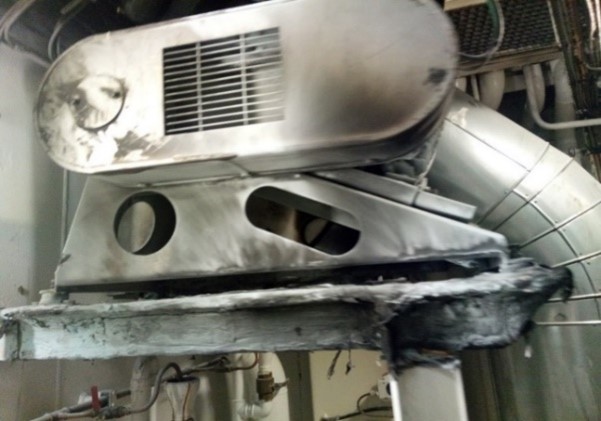Fires and fire risks on vessels
Fire in incinerator and exhaust fan motor
What happened?
An incinerator was being routinely operated by its designated operator. After the last garbage parcel was inserted into the chamber, the operator noticed flames and smoke coming out of the exhaust pipe and ash removal door. The bridge was immediately informed via radio. The operator left the room, and activated the emergency stop and the hi-fog system. The fire alarm was sounded and the crew mustered. While the fire teams responded to the fire in the incinerator, multiple fire sensors located in the casing and engine room were activated automatically. Fire fighters went to the engine room and found the exhaust fan motor from the incinerator on fire. The fire was extinguished by dry powder extinguisher.


What went wrong?
The exhaust fan holding bolts were found broken inside the casing. Investigation confirmed that the fire was caused by overloading the incinerator with plastic and thereby creating excessively high temperatures. This led to overheating of the exhaust fan which created an imbalance of the fan and consequent failure of the bolts.
- The manufacturer’s recommendations for maximum loads for the incinerator chamber, in terms of type and amount of waste, should be displayed at a conspicuous place near the incinerator;
- Further documented training/familiarisation for the operators;
- Segregation of waste as per garbage management plan.
Actions/lessons learned
- The manufacturer’s recommendations for maximum loads for the incinerator chamber, in terms of type and amount of waste, should be displayed at a conspicuous place near the incinerator;
- Further documented training/familiarization for the operators;
- Segregation of waste as per garbage management plan.
Members may wish to refer to
Safety Event
Published: 26 November 2020
Download: IMCA SF 32/20
IMCA Safety Flashes
Submit a Report
IMCA Safety Flashes summarise key safety matters and incidents, allowing lessons to be more easily learnt for the benefit of all. The effectiveness of the IMCA Safety Flash system depends on Members sharing information and so avoiding repeat incidents. Please consider adding [email protected] to your internal distribution list for safety alerts or manually submitting information on incidents you consider may be relevant. All information is anonymised or sanitised, as appropriate.
IMCA’s store terms and conditions (https://www.imca-int.com/legal-notices/terms/) apply to all downloads from IMCA’s website, including this document.
IMCA makes every effort to ensure the accuracy and reliability of the data contained in the documents it publishes, but IMCA shall not be liable for any guidance and/or recommendation and/or statement herein contained. The information contained in this document does not fulfil or replace any individual’s or Member's legal, regulatory or other duties or obligations in respect of their operations. Individuals and Members remain solely responsible for the safe, lawful and proper conduct of their operations.
